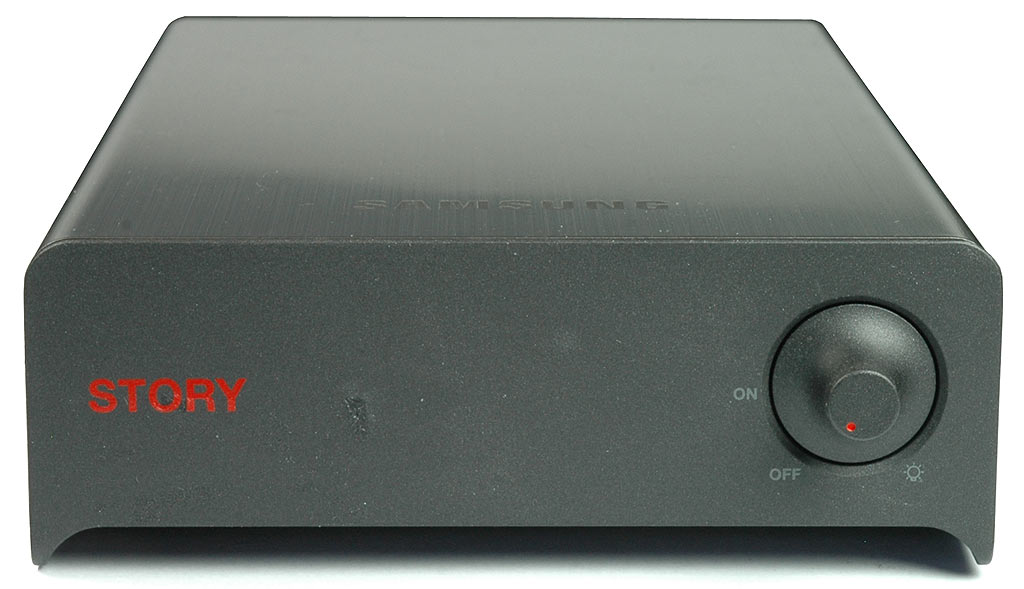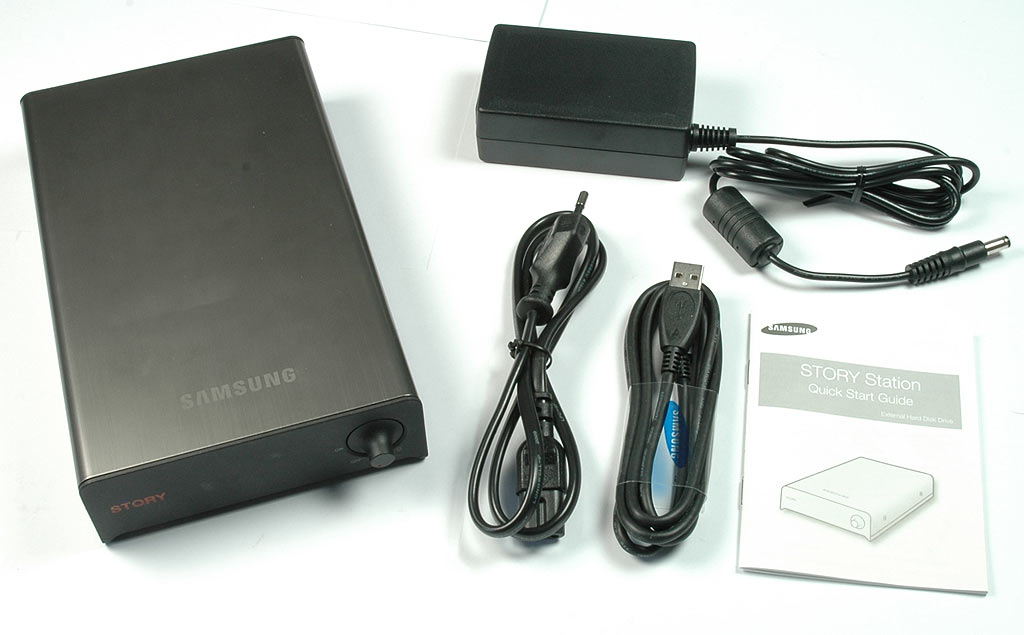A Lesson In Backup: Taking Care Of Your Data
External Hard Disk Backup: The Case Of The Samsung Story Station
As we’ve already noted, would-be buyers will find a huge selection of external hard disks available to them. Compared to internal drives, these products are more expensive, but both OEMs and drive manufacturers add value to them by bundling software and adding features—including backup software, as a very good example. Let’s take a look at the external Story Station drive from Samsung, and see how it stacks up.
Retro Design
The Story Station enclosure is made of plastic and brushed aluminum, as is typical for this product category. The design is boxy, and its appearance reminds us of consumer electronics from the 1970s or perhaps modular car audio components from a vendor like Alpine or Polk Audio. The workmanship is nevertheless of high quality.
The front panel of the Story Station is completely gray, and features only a logo in red at the left, and a control knob at the right. The same look and layout that characterize the front of the unit, also apply to the rear view as well, including another red stencil. There, you’ll also find a Type B mini-USB jack and a power jack for the unit’s external power supply, both of which are highlighted with red plastic housings in the same color as the stenciled artwork on the case.
Because the enclosure features ventilation slits on its rear and underside, and the all-aluminum housing itself facilitates heat transfer, we never measured any significant heat build-up on the hard disk itself. The sidewalls also help with heat transfer from the bottom metal plate on the drive, by leaving room for air to circulate inside the case and out the ventilation slits. A single white LED on the bottom, behind the front edge of the case, lights up to indicate read/write activity on the drive. Although it points downward, the shape of the enclosure makes it easy to see this LED at work.
Retail Package Contents and Software
Inside the box, you’ll find an external power supply along with a power cable, a USB cable, and a printed user manual, plus the Story Station itself. As with most devices in this product category, Samsung doesn’t skimp on the software bundle included with this unit either. Instead of adding a CD to the box, however, Samsung chose to write the installation files and a PDF version of the manual right onto the Story Station’s hard disk.
Get Tom's Hardware's best news and in-depth reviews, straight to your inbox.
Using the included software, users can schedule regular backups (with Samsung Auto Backup), and protect their backup sets with a password if they like (with SafetyKey). Users can also install a virtual hard disk on the Story Station called SecretZone, which keeps its contents hidden from other users who may log onto your PC. Overall, this puts Samsung’s offerings on par with the software that Seagate provides with its FreeAgent Pro or that Western Digital delivers with its MyBook series of external hard disks.
| Model | Samsung Story Station |
| Capacity | 1.5 TB, 1 TB, 500 GB |
| Weight | ~2.2 lbs (~ 1 Kg) |
| Dimensions (H x W x d) | 1.65” x 4.70” x 7.59” (41.85 x 119.5 x 192.8 mm) |
| Interface | USB 2.0 |
| OSes supported | Windows 2000/XP/VistaMac OS X 10.4.8 or Later |
| Features | Adjustable LED brightnessSamsung Auto BackupSecretZoneSafetyKey |
| Warranty | 3 years |
Current page: External Hard Disk Backup: The Case Of The Samsung Story Station
Prev Page Trends In External Storage Next Page Where To Put Those Files? Data Organization-
truehighroller I just had an External Hard Drive die on me. The drive had all of our family pictures from the last 4 1/2 years on it.Reply
I managed to get, getbackdata to work for me but, it took 48 hrs for it to read the data and make an image of it on to a new hard drive that I bought "internal".
I instantly after managing to get them back, put them on a DVD as well. Could of cost us a $1000 if I didn't know what I was doing. -
Too many people make that mistake... store their files on an external HD and think they are 'backed up'.Reply
They are only backed up if another, duplicate copy is held somewhere separate to the first copy. Keeping photos *only* on an external drive is not being backed-up!
You were lucky to get them back... far to many people don't back up and learn the hard way...and unfortunately, usually there's no prior warning of when a drive fails. -
zodiacfml yeah. same with the guy above, i have more than 4 years of pics and vids but i don't have an external or network drive, just uploaded them online.Reply -
My backup solution? Using Ghost 2003, I backup my hard drive to a image file that is stored on a 1 TB drive. Then, I ghost the entire 1 TB drive over to another 1 TB which is then stored off-site.Reply
-
pbrigido I have thought about purchasing a 32GB cheap MLC SSD to use as a backup for pictures to eliminate the mechanical failure aspect of a conventional HD. I wonder how long a SSD can be without power before the memory cells lose their information.Reply -
truehighroller TorchWoodMy backup solution? Using Ghost 2003, I backup my hard drive to a image file that is stored on a 1 TB drive. Then, I ghost the entire 1 TB drive over to another 1 TB which is then stored off-site.Reply
As long as it is stored on a Raid 1 or 0+1, 5 , 10 then you should be ok. The drive that crashed on me had an image of an install on it as well and all the files "pictures" were part of that image. Now I have a recent copy of everything on a DVD as well. -
Shadow703793 It's good to have an External USB/eSATA drive for back ups but those drives should also be backed up to a more "permanent" storage solution such as DVD or even tape (Yes, I know, it's old school). The best method of backing up critical files (such as a very important CAD file for a product, PhD Thesis,etc) should be backed up online. The best free online back up solution is to create a Gmail account and use GmailFS. For more info see: http://www.viksoe.dk/code/gmail.htmReply
DL here: http://www.softpedia.com/progDownload/GMail-Drive-shell-extension-Download-15944.html
That's what I use. With ~7GB worth of space, it's enough to back up important files. -
MU_Engineer I am a little surprised that this article was on a geek-oriented website like THG. I was hoping to see something like setting up a RAID NAS or a home server and then automating the backup process. I mean, wasn't expecting to see anything significantly complex like setting up a headless server, writing a shell script to sort and move files by file type, and then setting up an automated differential backup system to run on a schedule. But come on, the article was just how to plug in a external USB hard drive, sort some files with the Vista GUI and manually run a couple of GUI backup tools.Reply -
Katsushiro I too was disappointed with the lack of techyness in this article. I don't recall a single mention of a RAID solution. And I didn't see anything that could help me; I have a 160GB raptor and a 500GB media drive that I want to automatically mirror/backup both to a 750GB drive.Reply


